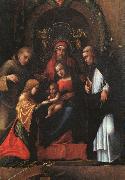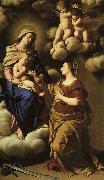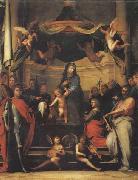Wholesale Oil Painting No Minimum |
|||||||||||
|
|
|||||||||||

|
|||||||||||
|
|
|
||||||||
CorreggioItalian 1489-1534 Correggio Locations Italian painter and draughtsman. Apart from his Venetian contemporaries, he was the most important northern Italian painter of the first half of the 16th century. His best-known works are the illusionistic frescoes in the domes of S Giovanni Evangelista and the cathedral in Parma, where he worked from 1520 to 1530. The combination of technical virtuosity and dramatic excitement in these works ensured their importance for later generations of artists. His altarpieces of the same period are equally original and ally intimacy of feeling with an ecstatic quality that seems to anticipate the Baroque. In his paintings of mythological subjects, especially those executed after his return to Correggio around 1530, he created images whose sensuality and abandon have been seen as foreshadowing the Rococo. Vasari wrote that Correggio was timid and virtuous, that family responsibilities made him miserly and that he died from a fever after walking in the sun. He left no letters and, apart from Vasari account, nothing is known of his character or personality beyond what can be deduced from his works. The story that he owned a manuscript of Bonaventura Berlinghieri Geographia, as well as his use of a latinized form of Allegri (Laetus), and his naming of his son after the humanist Pomponius Laetus, all suggest that he was an educated man by the standards of painters in this period. The intelligence of his paintings supports this claim. Relatively unknown in his lifetime, Correggio was to have an enormous posthumous reputation. He was revered by Federico Barocci and the Carracci, and throughout the 17th and 18th centuries his reputation rivalled that of Raphael. |
||||||||
|
|
||||||||
The Mystic Marriage of St.Catherine
The Mystic Marriage of St.Catherine Painting ID:: 499 |
1510-15
National Gallery of Art, Washington DC 1510-15 National Gallery of Art, Washington DC |
|||||||
|
|
||||||||
Giovan Battista Salvi Sassoferrato1605-1685 Italian Giovan Battista Salvi Sassoferrato Gallery |
||||||||
|
|
||||||||
|
|
The Mystic Marriage of St.Catherine
The Mystic Marriage of St.Catherine Painting ID:: 3704 |
1650
Wallace Collection, London 1650 Wallace Collection, London |
||||||
|
|
||||||||
SANCHEZ COELLO, AlonsoSpanish Painter, ca.1531-1588 was a portrait painter of the Spanish Renaissance and one of the pioneers of the great tradition of Spanish portrait painting. Alonso Senchez Coello spent his childhood in Benifair de les Valls, until the death of his father when he was around ten years old. He was educated in Portugal at his grandfather's home. Coello's years in Portugal and his family name of Portuguese origin led to a long-standing belief that he was in fact Portuguese. His grandfather (after whom he was named) was in the service of King John III of Portugal who sent the young painter to study with Anthonis Mor (also known as Antonio Moro) in Flanders around 1550. He was under the service of Antoine de Granville, bishop of Arras, learning from Mor. While studying in Flanders, Coello also spent time copying some of Titian's works. In 1552, the painter went to Lisbon with Anthonis Mor when Charles V commissioned Mor to paint the Portuguese royal family. For a few years, Senchez Coello remained in Portugal working for the court of the heir to the throne, John, Crown Prince of Portugal. After the prince's death, Senchez Coello moved to the Spanish court of Philip II, having been recommended by the widow of John, Juana, who was the sister of the Spanish king. In 1555, S??nchez Coello was in Valladolid working for the Spanish court, and when Mor left Spain in 1561, Senchez Coello took his former master's place as Court Painter. Senchez Coello married Louisa Reyaltes in either 1560 or 1561 in Valladolid, and they had seven children. Coello's daughter, Isabel Senchez (1564-1612), |
||||||||
|
|
||||||||
|
|
The Mystic Marriage of St.Catherine
The Mystic Marriage of St.Catherine Painting ID:: 28109 |
mk61
1578
Oil on cork
164x80cm
mk61 1578 Oil on cork 164x80cm |
||||||
|
|
||||||||
Mateo cerezoSpanish gifted painter and colorist , c.1626-1666 |
||||||||
|
|
||||||||
|
|
The Mystic Marriage of St.Catherine
The Mystic Marriage of St.Catherine Painting ID:: 28133 |
mk61
1660
Oil on canvas
207x163cm
mk61 1660 Oil on canvas 207x163cm |
||||||
|
|
||||||||
BARTOLOMEO, Frab. 1473, Firenze, d. 1517 b. 1473, Firenze, d. 1517 He was born in Savignano di Prato, Tuscany. He received the nickname of Baccio della Porta for his house was near the Porta ("Gate") San Pier Gattolini. Starting from 1483 or 1484, by recommendation of Benedetto da Maiano, he apprenticed in the workshop of Cosimo Rosselli. In 1490 or 1491 he began a collaboration with Mariotto Albertinelli. In the late 1490s Baccio was drawn to the teachings of Fra Girolamo Savonarola, who denounced what he viewed as vain and corrupt contemporary art. Savonarola argued for art serving as a direct visual illustration of the Bible to educate those unable to read the book. From 1498 is his famous portrait of Savonarola, now in the Museo Nazionale di San Marco in Florence. The following year he was commissioned a fresco of the Universal Judgement for the Ospedale di Santa Maria Nuova, completed by Albertinelli and Giuliano Bugiardini when Baccio became a Dominican friar on July 26, 1500. The following year he entered the convent of San Marco. He renounced painting for several years, not resuming until 1504 when he became the head of the monastery workshop in obedience to his superior. In that year he began a Vision of St. Bernard for Bernardo Bianco's family chapel in the Badia Fiorentina, finished in 1507. Soon thereafter, Raphael visited Florence and befriended the friar. Bartolomeo learned perspective from the younger artist, while Raphael added skills in coloring and handling of drapery, which was noticeable in the works he produced after their meeting. With Raphael, he remained on the friendliest terms, and when he departed from Rome, left in his hands two unfinished pictures which Raphael completed. At the beginning of 1508 Bartolomeo moved to Venice to paint a Holy Father, St. Mary Magdalene and St. Catherine of Siena for the Dominicans of San Pietro Martire in Murano, influenced somewhat by Venetian colorism. As the Dominicans did not pay the work, he took it back to Lucca, where it can be seen now. Also in Lucca, in the October 1509, he painted by Albertinelli an altarpiece with Madonna and Child with Saints for the local cathedral. On November 26, 1510 Pier Soderini commissioned him an altarpiece for the Sala del Consiglio of Florence, now in the Museum of San Marco. Two years later he finished another altarpiece for the cathedral of Besancon. |
||||||||
|
|
||||||||
|
|
The Mystic Marriage of St.Catherine
The Mystic Marriage of St.Catherine Painting ID:: 29024 |
mk65
Oil on panel
138 3/16x105 1/8in
mk65 Oil on panel 138 3/16x105 1/8in |
||||||
|
|
||||||||
Domenico Beccafumic1486-1551 Domenico Beccafumi Gallery Italian painter, sculptor, draughtsman, printmaker and illuminator. He was one of the protagonists, perhaps even the most precocious, of Tuscan Mannerism, which he practised with a strong sense of his Sienese artistic background but at the same time with an awareness of contemporary developments in Florence and Rome. He responded to the new demand for feeling and fantasy while retaining the formal language of the early 16th century. None of Beccafumis works is signed or dated, but his highly personal maniera has facilitated almost unanimous agreement regarding the definition of his corpus and the principal areas of influence on it. However, some questions concerning the circumstances of his early career and the choices available to him remain unanswered. The more extreme forms of Beccafumis reckless experimentation underwent a critical reappraisal only in the later 20th century. |
||||||||
|
|
||||||||
|
|
The Mystic Marriage of St.Catherine
The Mystic Marriage of St.Catherine Painting ID:: 33270 |
mk83
c.1528
oil on wood
345.5x255.5cm
mk83 c.1528 oil on wood 345.5x255.5cm |
||||||
|
|
||||||||
|
Domenico Beccafumi c1486-1551 Domenico Beccafumi Gallery Italian painter, sculptor, draughtsman, printmaker and illuminator. He was one of the protagonists, perhaps even the most precocious, of Tuscan Mannerism, which he practised with a strong sense of his Sienese artistic background but at the same time with an awareness of contemporary developments in Florence and Rome. He responded to the new demand for feeling and fantasy while retaining the formal language of the early 16th century. None of Beccafumis works is signed or dated, but his highly personal maniera has facilitated almost unanimous agreement regarding the definition of his corpus and the principal areas of influence on it. However, some questions concerning the circumstances of his early career and the choices available to him remain unanswered. The more extreme forms of Beccafumis reckless experimentation underwent a critical reappraisal only in the later 20th century. The Mystic Marriage of St.Catherine mk83 c.1528 oil on wood 345.5x255.5cm |
||||||||
|
|
||||||||
|
Prev Next
|
||||||||
|
|
||||||||
|
Related Paintings to Domenico Beccafumi :. |
||||||||
|
|
||||||||
|
CONTACT US |






